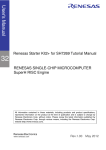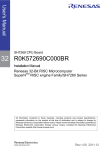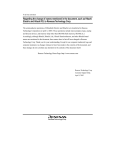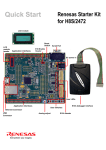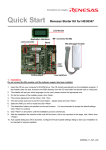Download Renesas SH7201 User's Manual
Transcript
Quick Start Renesas Starter Kit for SH7201 Reset switch User LEDs Power jack E10A for Starter Kits Debug Module LCD connector and module Application headers Analog adjust User switches E10A connector 1. Installation Do not connect the E10A module until the software support has been installed. 1. Insert the CD into your computer’s CD-ROM drive. The CD should automatically run the installation program. If the installer does not start, browse to the CD root folder and double click on ‘setup.exe’. 2. The installer will ask you which language is to be used, please choose the appropriate one and click <OK>. 3. On the first screen of the installer proper, click <Next>. 4. The License Agreement will be shown, read and click <Yes>. 5. The next screen asks you to pick the world region – please select and click <Next>. 6. Select the RSK you wish to install and click <Next> to continue. 7. The destination folders are specified on the next screens. It is recommended to accept the default settings. Click <Next> to continue. 8. Click <Next> on all screens until the Installation process commences. 9. After the installation the machine’s site code will be shown, this is not important at this stage, click <Next> then <Finish>. 10. The Auto-update dialog box will be launched. Configure the Auto-update settings dialog to allow your installation to be checked for updates. D007124_11_S01_V03 2. Connection 11. Connect the E10A module to the ‘E10A’ connector on the RSK using the ribbon cable. 12. Plug in the LCD module to ‘LCD’ connector on the RSK ensuring that the pin 1 designation corresponds to the marking on the RSK. 13. Connect the 5V power supply unit to the power jack on the RSK board and apply power. The green ‘Power’ LED located on the RSK will illuminate. 14. Connect the E10A module to a spare USB port on your PC. The green ‘ACT’ LED on the RSK will illuminate. The ‘Found New Hardware’ Wizard will appear. Please follow the steps below to install the drivers. Note that administrator privileges are required for a Windows™ 2000/XP machine. If offered, do not use the Windows Update option to locate the driver. 15. Verify the “Recommended” option (Renesas E-Series USB Driver) is selected and click <Next>. 16. If using Windows XP, skip to step 18; otherwise click <Next>. 17. Click <Next> to install the driver. 18. Click <Finish> to close the wizard. Note: The Windows driver signing dialog may be displayed. Please accept the driver to continue. 3. HEW Workspace HEW integrates various tools such as compiler, assembler, debugger and editor into a common graphical user interface. To learn more on how to use HEW, open the HEW manual installed on your computer (Start Menu > All Programs > Renesas > High-performance Embedded Workshop > Manual Navigator). 19. Launch HEW from the Start Menu (Start Menu > All Programs > Renesas > High-performance Embedded Workshop). 20. In the “Welcome” dialog box: Verify “Create New Workspace” is selected. Click <OK> 21. In the “New Project Workspace” dialog box: Verify the “CPU Family” is set to “SuperH RISC engine”. Select “E10A_RSKSH7201” from the left hand pane. 22. Enter a name for the workspace. The project name will be automatically completed with the Workspace name. You can change this name to ‘Tutorial’ if required. Click <OK>. 23. On the “E10A_RSKSH7201 – Step 1” window: Select “Tutorial” and click <Next>. 24. On the “E10A_RSKSH7201 – Step 2” window: Click <Finish>. 25. On the Project Generator Information window: Click <OK>. The project that is created has two configurations. The Release configuration compiles the project without any debugger support and can be used for the final release code version. 26. Select the ‘Debug’ build configuration in the left hand drop down list on the tool bar. 27. Click on the ‘Build’ icon to compile, assemble and link the project. 4. Programming and Debug 28. Select the “SessionSH2A_FPU_E10A_USB_SYSTEM” session in the right hand drop down list on the tool bar. 29. Click the <Connect> button on the debug toolbar. 30. The ‘Select Emulator mode’ dialog will appear. Select the device “SH7201” and the “E10A-USB Emulator” radio button and click <OK>. If this isn’t the first time you have used the E10A module with this RSK, please skip to step 35. D007124_11_S01_V03 First use of the E10A module 31. The ‘Please choose driver’ dialog will be shown. Click <OK> 32. The ‘Driver Details’ dialog will be shown, please select “Renesas E-Series USB Driver” as illustrated. The ‘Interface’ and ‘Channel’ items will be automatically populated. Click <Close>. 33. The Firmware setup dialog will be shown warning you not to disconnect the USB cable until the firmware download is complete. Click <OK>. 34. The firmware will be downloaded to the E10A module; this will take a few moments. Please do not disconnect the E10A from the host during download, doing so is likely to damage the E10A module. 35. A box will appear; “Please reset the user system and press <Enter> key.” 36. Press the “Reset” button on the RSK and press <Enter> (or click <OK>). 37. HEW will connect to the target system. 38. Click on the ‘Emulator System’ button in HEW. 39. The “Configuration” dialog will appear, select the “Loading Flash memory” tab. 40. Select the “Enable” radio on both loading and erasing flash memory. 41. Click the <Browse> button and navigate to the project folder (Usually located in c:\WorkSpace\<project_name>) and select the “fmtool_e10a.mot” file, click <Open>. 42. Check the settings against the picture to the right. 43. Click <OK> on the “Configuration” dialog. 44. Right click on the <project_name>.abs file listed in the download modules area of the Workspace view and select “Download”. 45. The “Downloading program” window will show the progress of the download, once completed it will disappear. 46. Next, the “Disassembly” view will show. 47. Click the ‘Go’ button. 48. The code will run. You will see the LEDs flashing on the board. After pressing any of the user switch, the rate of flashing can be adjusted using the Analog Adjust control. 49. Click the ‘Stop’ button. The code will stop and the source code opened at the current program counter. 5. Next Step After you have completed this quick start procedure, please review the tutorial code and sample code that came with the kit. You can add projects to the current workspace by selecting (Project > Insert Project) from the main menu. The tutorials will help you understand the device and development process using Renesas Development Tools. The Hardware manual supplied with this RSK is current at the time of publication. Please check for any updates to the device manual from the Renesas website at: www.renesas.com/renesas_starter_kits D007124_11_S01_V03 6. Renesas SuperH Compiler The version of the compiler provided with this RSK is fully functional but time limited. You have 60 days to evaluate the full product before the compiler will limit the code linker to 256k bytes. Full licensed SH compiler versions are available from your Renesas supplier. 7. Support Online technical support and information is available at: www.renesas.com/renesas_starter_kits Technical Contact Details America: [email protected] Europe: [email protected] Japan: [email protected] Note on Autoupdate: The Autoupdater is configured to automatically add itself to the Startup folder in the Windows Start Menu and use the registry defaults for access to the web. After restarting the machine the Icon will appear in the System Tray next to the clock. To change the settings or access Autoupdate, simply right-click on the icon and use the menu that appears. © Renesas Solutions Corporation. 2008. © Renesas Technology Corporation. 2008. © Renesas Technology Europe Ltd. 2008. D007124_11_S01_V03





